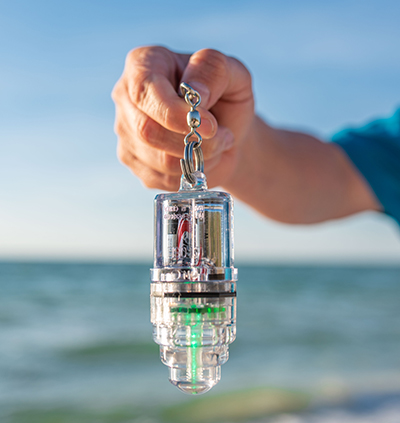After years of studying sea turtles in Ghana, Florida Gulf Coast University vertebrate zoology associate professor Phil Allman found a way to save them. In a new study, Allman proves a simple, low-cost innovation reduces the number of endangered sea turtles killed because of fishing nets operated by small-scale fisheries. It’s a light shown on a sometimes-overlooked industry section that negatively impacts sea turtle populations.

“Research published 10 years ago reported 85,000 sea turtle deaths annually across the globe, but the number of participating boats represent less than 1% of the global fishing effort,” said Allman. “The magnitude of sea turtle bycatch is unsustainable and driving sea turtles closer to extinction.”
Working with a small team, Allman partnered with fishers in Ghana to modify fishing nets. He installed several green LED lights around each net, a simple change that has worked in commercial fisheries. Allman said this is the first study to try the same lights on nets operated by their small-scale counterparts.
“Across two separate studies in different fishing communities, the experimental nets with lights captured 81% fewer turtles than the control nets (without lights),” said Allman, who works in the university’s Department of Biological Sciences.
In 2015, the first year of the study, Allman and his colleagues observed 15 gillnet fishing boats in Ghana. In that time, 64 turtles were killed or approximately four turtles per vessel per year. According to NOAA Fisheries, a gillnet is a “wall” of nylon netting that “hangs in the water column.” While it works well for capturing fish, it also kills other species. NOAA Fisheries notes that in the case of sea turtles, the animal gets tangled in the net and drowns if unable to reach the surface.
According to Allman, Ghana has roughly 12,000 registered gillnet boats. He believes there are “several thousand” others working without governmental authorization. Simple math could lead one to surmise that Ghana gillnet fishers kill upward of 48,000 sea turtles each year.
“Clearly, the Ghanaian gillnet fishery may be responsible for thousands of sea turtle deaths each year, but this is likely just a tiny fraction of what is captured globally,” Allman said.
Allman believes this finding could have a significant impact on sea turtles. He saw many killed by gillnets during his study, including olive ridley, green and leatherback species. The latter was important to Allman because, he said, this was also the first study to test the effect of green LED lights on leatherbacks.

“The leatherback population in the Pacific Ocean is considered critically endangered and requires immediate action to prevent the population from completely disappearing. We hope this study gives fishers confidence the readily available green LED lights can serve as an easy and affordable strategy to reduce sea turtle interactions in their gillnet fishery,” Allman said.
And why wouldn’t it? Allman demonstrated the green LED lights do not impact the size of a fisher’s target catch nor the market value of their product. Moreover, Allman is hopeful this innovation will appeal to Ghanaian fishers who know the capturing of sea turtles can be costly.
“Fishers in Ghana do not like catching turtles because the turtles damage or even destroy their net, and it can be quite expensive and time consuming to repair. Any amount of time they cannot fish is lost food and income necessary to support their family. They also do not like catching sea turtles because it is a taboo,” Allman added.
The fisher is trading the potential cost of the damage for a relatively low cost to light a net, Allman said.
“Including battery changes every six months (AA batteries), it cost a fisher approximately $130 to $165 to run the lights for three years. A turtle captured in the net will often cause significant damage to the net, which would often require replacing multiple sections. This can cost about $225 to replace. Given that we found a fishing vessel catches around four turtles per year, it is cost effective to use the lights.”
Whether commercial or small scale, Allman hopes fisheries take advantage of innovations like this to impact sea turtle populations significantly.
The study is published in the journal “Conservation Biology” from the Society of Conversation Biology.